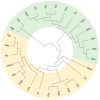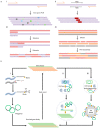Thermophilic Nucleic Acid Polymerases and Their Application in Xenobiology
- PMID: 36499296
- PMCID: PMC9738464
- DOI: 10.3390/ijms232314969
Thermophilic Nucleic Acid Polymerases and Their Application in Xenobiology
Abstract
Thermophilic nucleic acid polymerases, isolated from organisms that thrive in extremely hot environments, possess great DNA/RNA synthesis activities under high temperatures. These enzymes play indispensable roles in central life activities involved in DNA replication and repair, as well as RNA transcription, and have already been widely used in bioengineering, biotechnology, and biomedicine. Xeno nucleic acids (XNAs), which are analogs of DNA/RNA with unnatural moieties, have been developed as new carriers of genetic information in the past decades, which contributed to the fast development of a field called xenobiology. The broad application of these XNA molecules in the production of novel drugs, materials, and catalysts greatly relies on the capability of enzymatic synthesis, reverse transcription, and amplification of them, which have been partially achieved with natural or artificially tailored thermophilic nucleic acid polymerases. In this review, we first systematically summarize representative thermophilic and hyperthermophilic polymerases that have been extensively studied and utilized, followed by the introduction of methods and approaches in the engineering of these polymerases for the efficient synthesis, reverse transcription, and amplification of XNAs. The application of XNAs facilitated by these polymerases and their mutants is then discussed. In the end, a perspective for the future direction of further development and application of unnatural nucleic acid polymerases is provided.
Keywords: nucleic acid polymerases; thermophilic enzymes; thermophilic organisms; xeno nucleic acids (XNAs); xenobiology.
Conflict of interest statement
The authors declare no conflict of interest.
Figures






Similar articles
-
Polyamines promote xenobiotic nucleic acid synthesis by modified thermophilic polymerase mutants.RSC Chem Biol. 2024 Apr 4;5(5):467-472. doi: 10.1039/d4cb00017j. eCollection 2024 May 8. RSC Chem Biol. 2024. PMID: 38725908 Free PMC article.
-
Synthesis, Reverse Transcription, Replication, and Inter-Transcription of 2'-Modified Nucleic Acids with Evolved Thermophilic Polymerases: Efforts toward Multidimensional Expansion of the Central Dogma.ACS Synth Biol. 2023 Sep 15;12(9):2616-2631. doi: 10.1021/acssynbio.3c00213. Epub 2023 Aug 30. ACS Synth Biol. 2023. PMID: 37646406
-
Transcription, Reverse Transcription, and Amplification of Backbone-Modified Nucleic Acids with Laboratory-Evolved Thermophilic DNA Polymerases.Curr Protoc. 2021 Jul;1(7):e188. doi: 10.1002/cpz1.188. Curr Protoc. 2021. PMID: 34232574
-
From polymerase engineering to semi-synthetic life: artificial expansion of the central dogma.RSC Chem Biol. 2022 Aug 9;3(10):1173-1197. doi: 10.1039/d2cb00116k. eCollection 2022 Oct 5. RSC Chem Biol. 2022. PMID: 36320892 Free PMC article. Review.
-
Beyond DNA and RNA: The Expanding Toolbox of Synthetic Genetics.Cold Spring Harb Perspect Biol. 2019 Jun 3;11(6):a032490. doi: 10.1101/cshperspect.a032490. Cold Spring Harb Perspect Biol. 2019. PMID: 31160351 Free PMC article. Review.
Cited by
-
Polyamines promote xenobiotic nucleic acid synthesis by modified thermophilic polymerase mutants.RSC Chem Biol. 2024 Apr 4;5(5):467-472. doi: 10.1039/d4cb00017j. eCollection 2024 May 8. RSC Chem Biol. 2024. PMID: 38725908 Free PMC article.
-
A robust strategy for overexpression of DNA polymerase from Thermus aquaticus using an IPTG-independent autoinduction system in a benchtop bioreactor.Sci Rep. 2025 Feb 18;15(1):5891. doi: 10.1038/s41598-025-89902-4. Sci Rep. 2025. PMID: 39966433 Free PMC article.
-
Direct Enzyme Engineering of B Family DNA Polymerases for Biotechnological Approaches.Bioengineering (Basel). 2023 Sep 30;10(10):1150. doi: 10.3390/bioengineering10101150. Bioengineering (Basel). 2023. PMID: 37892880 Free PMC article. Review.
-
The XNA alphabet.Nucleic Acids Res. 2025 Jul 8;53(13):gkaf635. doi: 10.1093/nar/gkaf635. Nucleic Acids Res. 2025. PMID: 40650979 Free PMC article. Review.
-
Strategies and procedures to generate chimeric DNA polymerases for improved applications.Appl Microbiol Biotechnol. 2024 Aug 21;108(1):445. doi: 10.1007/s00253-024-13276-2. Appl Microbiol Biotechnol. 2024. PMID: 39167106 Free PMC article. Review.
References
Publication types
MeSH terms
Substances
Grants and funding
LinkOut - more resources
Full Text Sources
Miscellaneous

